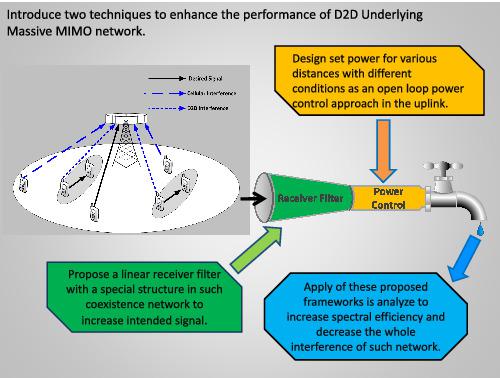当前位置:
X-MOL 学术
›
Int. J. Commun. Syst.
›
论文详情
Our official English website, www.x-mol.net, welcomes your
feedback! (Note: you will need to create a separate account there.)
Better spectral efficiency of device to device underlying massive multi‐input multi‐output using receiver filter algorithm and power control model
International Journal of Communication Systems ( IF 1.7 ) Pub Date : 2021-01-26 , DOI: 10.1002/dac.4655 Faezeh Heydari 1 , Saeed Ghazi‐Maghrebi 2 , Ali Shahzadi 2 , Mohammad Jalal Rastegar Fatemi 1
International Journal of Communication Systems ( IF 1.7 ) Pub Date : 2021-01-26 , DOI: 10.1002/dac.4655 Faezeh Heydari 1 , Saeed Ghazi‐Maghrebi 2 , Ali Shahzadi 2 , Mohammad Jalal Rastegar Fatemi 1
Affiliation

|
Benefits of device to device (D2D) underlying massive multi‐input multi‐output (MIMO) cellular networks are noticeable in the fifth generation (5G) of mobile broadband networks. However, the interference of such coexistence from massive MIMO and D2D, due to resource sharing between cellular users and D2D users, should be decreased. Because of this issue, the spectral efficiency of such networks will be reduced. The challenges of such networks are to control the transmit power of their users and to mitigate cellular‐to‐D2D and D2D‐to‐cellular interferences. In this paper, we introduce two techniques to enhance the performance of these systems. Since, we propose a linear receiver filter with a special structure in such coexistence network to increase intended signal and then to increase spectral efficiency. Also, in this research, to decrease the whole interference, by explaining power sets for cellular and D2D transmitter for various distance intervals, we apply an open loop power control approach in the uplink as a suboptimal solution. This solution is a closed‐form solution and is often more useful and take lower time than the optimal solution. Also, we analyze spectral efficiency for the cellular uplink of such networks with the proposed frameworks. Numerical results approve that the two proposed techniques decrease the interferences. Simulation results demonstrate an enhancement in the cellular spectral efficiency.
中文翻译:

使用接收器滤波器算法和功率控制模型,设备对大规模底层多输入多输出的设备的频谱效率更高
在第五代(5G)移动宽带网络中,基于大规模多输入多输出(MIMO)蜂窝网络的设备到设备(D2D)的优势是显而易见的。但是,应减少由于蜂窝用户和D2D用户之间的资源共享而导致的大规模MIMO和D2D共存的干扰。由于此问题,将降低此类网络的频谱效率。这种网络的挑战是控制其用户的发射功率并减轻蜂窝到D2D和D2D到蜂窝的干扰。在本文中,我们介绍了两种技术来增强这些系统的性能。因此,我们在这种共存网络中提出了一种具有特殊结构的线性接收器滤波器,以增加预期信号,然后增加频谱效率。另外,在这项研究中 为了降低整体干扰,通过解释蜂窝和D2D发射机在不同距离间隔的功率集,我们在上行链路中采用开环功率控制方法作为次优解决方案。此解决方案是封闭形式的解决方案,通常比最佳解决方案更有用,并且花费的时间更少。此外,我们利用提出的框架分析了此类网络的蜂窝上行链路的频谱效率。数值结果表明,所提出的两种技术可以减少干扰。仿真结果证明了细胞频谱效率的提高。此解决方案是封闭形式的解决方案,通常比最佳解决方案更有用,并且花费的时间更少。此外,我们利用提出的框架分析了此类网络的蜂窝上行链路的频谱效率。数值结果表明,所提出的两种技术可以减少干扰。仿真结果证明了细胞频谱效率的提高。此解决方案是封闭形式的解决方案,通常比最佳解决方案更有用,并且花费的时间更少。此外,我们利用提出的框架分析了此类网络的蜂窝上行链路的频谱效率。数值结果表明,所提出的两种技术可以减少干扰。仿真结果证明了细胞频谱效率的提高。
更新日期:2021-02-12
中文翻译:

使用接收器滤波器算法和功率控制模型,设备对大规模底层多输入多输出的设备的频谱效率更高
在第五代(5G)移动宽带网络中,基于大规模多输入多输出(MIMO)蜂窝网络的设备到设备(D2D)的优势是显而易见的。但是,应减少由于蜂窝用户和D2D用户之间的资源共享而导致的大规模MIMO和D2D共存的干扰。由于此问题,将降低此类网络的频谱效率。这种网络的挑战是控制其用户的发射功率并减轻蜂窝到D2D和D2D到蜂窝的干扰。在本文中,我们介绍了两种技术来增强这些系统的性能。因此,我们在这种共存网络中提出了一种具有特殊结构的线性接收器滤波器,以增加预期信号,然后增加频谱效率。另外,在这项研究中 为了降低整体干扰,通过解释蜂窝和D2D发射机在不同距离间隔的功率集,我们在上行链路中采用开环功率控制方法作为次优解决方案。此解决方案是封闭形式的解决方案,通常比最佳解决方案更有用,并且花费的时间更少。此外,我们利用提出的框架分析了此类网络的蜂窝上行链路的频谱效率。数值结果表明,所提出的两种技术可以减少干扰。仿真结果证明了细胞频谱效率的提高。此解决方案是封闭形式的解决方案,通常比最佳解决方案更有用,并且花费的时间更少。此外,我们利用提出的框架分析了此类网络的蜂窝上行链路的频谱效率。数值结果表明,所提出的两种技术可以减少干扰。仿真结果证明了细胞频谱效率的提高。此解决方案是封闭形式的解决方案,通常比最佳解决方案更有用,并且花费的时间更少。此外,我们利用提出的框架分析了此类网络的蜂窝上行链路的频谱效率。数值结果表明,所提出的两种技术可以减少干扰。仿真结果证明了细胞频谱效率的提高。











































 京公网安备 11010802027423号
京公网安备 11010802027423号